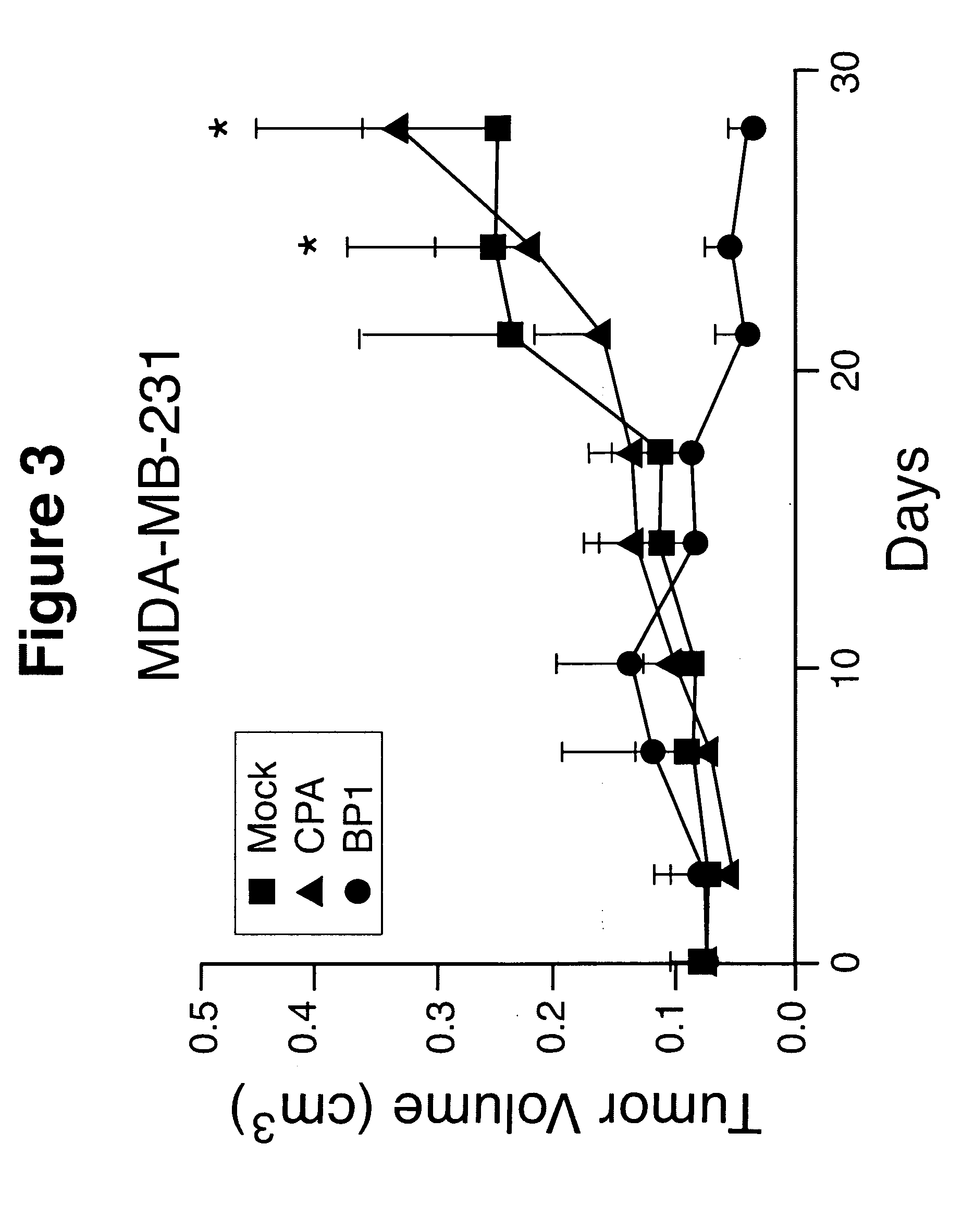Inhibition of placenta growth factor (PLGF) mediated metastasis and/or angiogenesis
a growth factor and placenta technology, applied in the field of inhibiting angiogenesis, can solve the problems of not always achieving durable responses or even cures, and the role of vegf and other members of the vegf family of growth factors in tumor recurrence or metastatic growth, so as to prevent tumors from metastasizing and inhibit or eliminate tumor metastasis
- Summary
- Abstract
- Description
- Claims
- Application Information
AI Technical Summary
Benefits of technology
Problems solved by technology
Method used
Image
Examples
example 1
Effects of PlGF on Tumor Cell Growth, Mobility, Angiogenesis and Metastasis
Methods and Materials
[0228] Immunohistochemistry, Histopathology and Flow Cytometry
[0229] Flow cytometry was performed by standard methods using 1-5 μg / ml primary antibody, and 1:500 dilution of FITC-labeled secondary antibody (Biosource International, Camarillo, Calif.). Data were collected on a BD FACSCalibur flow cytometer (BD Biosciences) using Cell Quest software.
[0230] Paraffin-embedded primary breast cancer tissue arrays from US Biomax Inc. (Rockville, Md.) and TARP, NCI (Bethesda, Md.) were stained using standard immunohistochemistry procedures (Taylor et al., 2002a) for PlGF and VEGF expression. Tissue arrays were also probed for Flt-1 or NRP-1 (ABXIS, Seoul, Korea). Slides were deparaffinized, blocked with appropriate normal serum, and incubated with antibodies purchased from Santa Cruz Biotechnology, Inc. (Santa Cruz, Calif.). After incubation with the primary antibody, biotinylated secondary ...
example 2
Inhibition of PlGF Mediated Angiogenesis in a Mouse Corneal Assay
[0292] The ability of PlGF ligands to block PlGF-mediated angiogenesis in corneal tissues in vivo is investigated. Corneal micropockets are created using a modified von Graefe cataract knife in both eyes of male 5-6-wk-old C57B16 / J mice. Micropellets comprised of a sustained release formulation of polyglucuronic acid / polylactic acid containing 100 ng of PlGF or PlGF with 1 μM BP-1, BP-2, BP-3 or BP-4 are implanted into each corneal pocket. Eyes are examined by a slit-lamp biomicroscope on day 5 after pellet implantation. Vessel length and neovascularization are measured.
[0293] PlGF induces a strong angiogenic response with formation of a high density of microvessels. Addition of BP-1, BP-3 or BP-4 inhibits PlGF mediated angiogenesis in corneal tissues. Treatment of a subject of diabetic retinopathy or macular degeneration results in an inhibition of blood vessel formation and ameliorates the condition.
example 3
BP1 Fusion Proteins and Conjugates
[0294] For purposes of oral administration or in other embodiments, BP1 and its analogs may be recombinantly or chemically linked to a carrier protein. For linking peptides composed of the 20 common L-amino acids found in naturally occurring proteins, recombinant DNA methods are preferred. For linking peptide mimetics or peptides that contain D-amino acids, modified amino acids, or unnatural amino acids, only chemical conjugation methods are currently feasible. As disclosed herein, a general method of preparing conjugates of BP1 linked to the carbohydrates of the Fc of human IgG1 (hFc) is provided. Methods of constructing three exemplary fusion proteins comprised of BP1 and hFc are disclosed below.
[0295] A vector for expressing hFc in myeloma cells is prepared using standard recombinant DNA techniques. The expression vector shCD20-Fc-pdHL2 (FIG. 6) is used as the DNA template to amplify the coding sequences for Fc (hinge, CH2, and CH3 domains) by ...
PUM
| Property | Measurement | Unit |
|---|---|---|
| volume | aaaaa | aaaaa |
| temperatures | aaaaa | aaaaa |
| concentrations | aaaaa | aaaaa |
Abstract
Description
Claims
Application Information
 Login to View More
Login to View More - R&D
- Intellectual Property
- Life Sciences
- Materials
- Tech Scout
- Unparalleled Data Quality
- Higher Quality Content
- 60% Fewer Hallucinations
Browse by: Latest US Patents, China's latest patents, Technical Efficacy Thesaurus, Application Domain, Technology Topic, Popular Technical Reports.
© 2025 PatSnap. All rights reserved.Legal|Privacy policy|Modern Slavery Act Transparency Statement|Sitemap|About US| Contact US: help@patsnap.com



